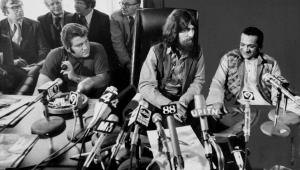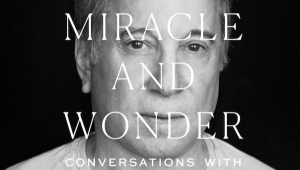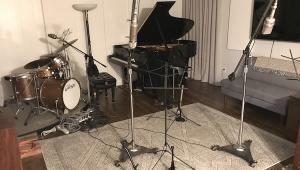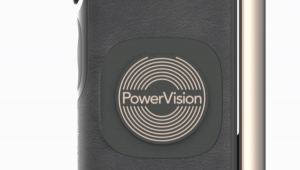... Doug Sax's preferred phono cartridge - the Stanton 881S.
Wilson Audiophile Recordings Series Reissues From Analogue Productions
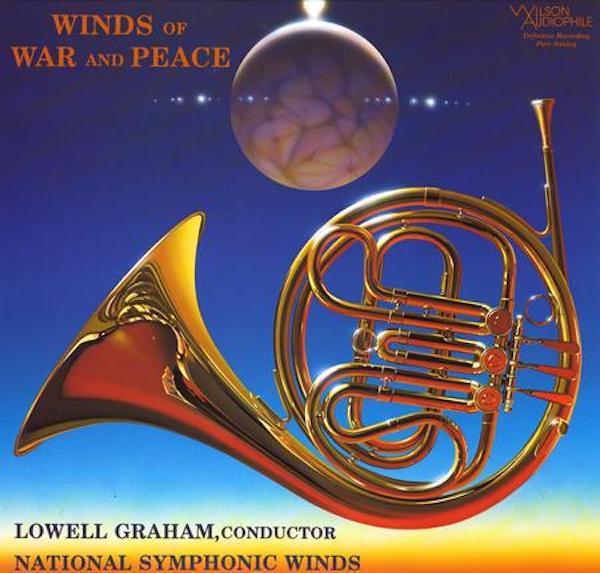
The post Recital music was mostly either sublime chamber or bombastic military band. That may sound odd, but to paraphrase Donald Rumsfeld, “when you go to record, you go with the artists you have, not the artists you wish you had”—which is not to write anything bad about who Dave Wilson recorded because the chamber artists have world-spanning distinguished careers and conductor Lowell Graham and The National Symphonic—essentially a pick-up band composed members of the country’s best military bands along with players from the Virginia Symphony, are equally well-credentialed. Those were the musicians to which Wilson had access.
The venues were always concert halls, not recording studios. The chamber music recordings were produced at Oakland, California’s Mills College, while the National Symphonic Winds were recorded at Hampton University in Hampton, Virginia in a historic hall. The two albums resulting from that session were both recorded the same day: September 17th, 1988.
In addition to chamber and military, the label released at least two other records, both interesting. One released in 1980 was The Apocalypse Now Sessions (Wilson Audiophile Recordings W-8521) with The Rhythm Devils. The members were Mickey Hart, Billy Kreutzmann, Airto Moriera, Phil Lesh and others. You could say it was essentially The Grateful Dead minus Jerry Garcia and Bob Weir. This one was produced by Mickey Hart and engineered by names familiar to any Deadhead: Betty Cantor-Jackson, Dan Healy and John Cutler among them, with cover art by Stanley Mouse. Believe me, the contrast between chamber and military is nothing compared to between Dave Wilson and Stanley Mouse—at least in terms of the character of their respective creative output since I’ve never met Mr. Mouse.
Apparently some contract lawyers argued the Grateful Dead angle and got an injunction stopping sale of The Apocalypse Now Sessions. Copies are scarce and pricey. Analogue Productions has a $215 copy for sale on its Wilson Audio page where you can find the currently available Wilson Audiophile Records reissues mastered from the original analog tapes by Kevin Gray at Cohearant and of course pressed on 200g vinyl by Quality Record Pressing.
The other one was called Test 1—Digital: How Accurate? I had forgotten all about it and that I owned it or perhaps I'd not have planned to issue a similar record using "Symphonic Dances", an episode many of you will remember. The music was two ragtime piano pieces played by Mark Wetch and one jazz selection by The Eddie Graham Trio. The recording was mastered twice: once cut directly from the analog master tape and once digitized and converted back to analog using the Soundstream PCM system that sampled at 50kHz with 16 bit depth.
The liner notes reprint a Fanfare magazine article by Neil Levinson (another name perhaps familiar to a few readers) that quotes an August 1983 Billboard Magazine exchange between Doug Sax, who needs no introduction and Peter Burkowitz who was then a consultant to PolyGram technical management. Sax said "Although digital storage is not my cup of tea, I nevertheless have a great respect for how well a professional digital recorder performs....no such respect for the CD, however." Sax went on to say "CD is the worst presentation of that (digital) technology....because all of the music will have these digital colorations...".
Burkowitz responded "Since Doug Sax seems to be rather short on facts, let me offer him one: skillfully adjusted and controlled 16-bit uniform quantization digital recording and reproduction including the CD, does not, and cannot add or subtract audible sensations of any kind. Period."
Choose your own reaction, but mine was "what a dick", which was the same reaction I had listening to Harman's Sean Olive on a "fake news" anti-vinyl NPR program he rigged a few years ago. In any case, if this tape still exists, maybe I'll pay to reissue it.
But I'm not here to talk about that one, but rather the others that have been reissued. The one I’ve chosen to highlight is the Winds of War and Peace (APC-8823) because it’s a sonic spectacular and while perhaps you are skeptical about this, it makes for damn entertaining listening. No doubt the RCA Symphony Orchestra’s reading of the Richard Rodgers score for the NBC television series “Victory At Sea” is more steady and sophisticated, under the baton of Robert Russell Bennett (who actually wrote the score based on themes provided by Rodgers), than the 9 minutes of excerpts here, but this reading by I suppose mostly young people who it turns out were handed the sheet music for the first time and told to “play” knowing it was being recorded, has its own built in drama of a different sort.
The album opens with John Williams’ “Liberty Fanfare”, written for the 1986 Statue of Liberty centennial celebration, which might remind you somewhat of the music for NBC’s “Nightly News”, which Williams also composed.. This track has some insanely deep and powerful giant bass drum “thwacks” hit with what conductor Lowell Graham describes as the “MOD” as in “Mallet of Death”. My darTzeel NHB-458 monobllock amplifiers have instant peak wattage meters on their fronts that register but a few watts until the “Mallet of Death” first strikes at which time they register close to 500 scary watts!
The drum sound is positively frightening and even dangerous. AT The International Consumer Electronics Show a few years ago I brought on a USB stick a vinyl transfer of this track at 96/24 resolution. It played fine in a bunch of rooms and everyone enjoyed the sound and especially the “thwack”, but in one room the first MOD hit literally vaporized a midrange ceramic cone, leaving the poor voice coil to “blow in the wind”!
If your system is capable of wide dynamic swings and deep bass, you’ll definitely enjoy cranking up this record! The original, cut by Doug Sax, did the damage so is obviously no “slouch”, but this Kevin Gray mastered reissue is even better overall. The bottom remains solid and dynamic while the midrange is far more transparent, having lost a “milky” quality that made it sound as if it had been recorded in an airplane hangar.
If chamber is more your style and/or more suited to your system I’d recommend Sonatas For Violin and Piano (Analogue Productions APC-8722) performed by David Abel (violin) and Julie Steinberg (piano). Incidentally, Wilson’s catalogue numbers begin with the release year, so this one was issued in 1987. These chamber music recordings were designed to create the sensation of the performers playing in your room as opposed to you being in a venue. Abel plays a silky-warm sounding Guarnerius built in 1719, while Steinberg’s instrument of choice is a Steinway Hamburg Model D concert grand. Given the minimal miking technique, recording to 30IPS 1/2” tape and the care taken in record production you can be sure that these records—all of them—will let you know how well your system performs. The QRP pressings produce pitch black backgrounds with which the originals cannot begin to compete. Plus the music is sublime and/or bombastic!
- Log in or register to post comments


the AT-ML170. The great mastering engineers prefer MM over MC.

Yes, some engineers prefered those MM both of you named over LOMC.
That fact means only that and does not means in anyway that are superior to LOMC.
Even has no sense that they choosed the 881 and ML170 over its top brothers that are better performers: 981 and ML180.
Exist excellent vintage MM/MI cartridges that even today can compete very well but even that 2-3 of them are really outstanding can't outperform the best vintage and today LOMC cartridges.
We need LOMC cartridge to honor those " thaws " in that recording.
Only an opinion.
Btw, you know who I'm and and would like to identify you if can email me or give me your moniker on other forums.
Thank's in advance.
Greetings.

... I'd be inclined to choose a top MM model from Ortofon or Audio-Technica.
https://www.analogplanet.com/content/nine-cartridges-compared-reviewed-a...
Why would you not want to use a cartridge which recording engineers have determined reproduces with a sound quality closest to that of the master tape (or mic feed for direct to disc)?
Perhaps your next group test could be between the Ortofon 2M Black and Audio-Technica VM760SLC and an assortment of low-output moving-coil cartridges.

when Doug made those statements he did not have access to some of the better modern MC cartridges. Having said that, there's still a certain magic about MM.
MM cartridges have a very prominent presence region, but at the same time they're not fatiguing. They also possess the proverbial balls and drive. These are also all attributes of tape.
Even the best MC cartridges today, such as Audio Technica, Ortofon, van den Hul, and Lyra have a tendency to unnaturally highlight some of the details. They're a bit leaner sounding and have somewhat recessed midranges.
MC can sound very good, but they mostly don't sound like tape IMO. Actually, nothing sounds like tape, but with MM one at least gets the idea.
I have experience with Studer, Otari, Revox, decks and have heard many master audio tapes of locally recorded jazz in Chicago.

... today's cartridges when he made those statements, about 30 years ago, it's not as though there weren't any MC cartridges available back then. For reference, the Stanton 881S was priced under $200.
In the mid to late 1980s, you could spend well over $1K on an MC from such sources as Argent, Dynavector, Miyabi and Van den Hul. Koetsu and Kiseki had cartridges priced above $2K and $3K, respectively. Wouldn't you expect one of those to be able to outperform the Stanton?
Around that same time JGH recommended, and used as a reference, the Ortofon MC2000 ($1K) if you wanted to hear "the truth."

That MC2000 LOMC cartridge you mentioned it's today a real challenge for almost any top cartridge, even the Etna. I'm saying is a contender, a serious one. I owned 3 samples.

... and neither are even close to today's best mc's.

Well, depends on what was your audio system when you owned and tested both Ortofon cartridges.
I agree that the 3000 is not up to the task but I think the MC2000 it's. First the 2000 must be mounted in a well matched tonearm due to its 11 weigth against its measured 30+cu and second must be listen it through an active very high gain and very low noise phonolinepreamp and not through a SUT.
After those please let me know against which today LOMC are you comparing it ( everything the same. ) ?
Regards.

then - well tempered turntable + arm, arc sp14/classic 60. martin logan cls.
now - technics sp10mk2/sme 309, luxman l590, harbeth monitor 30
contemporary cartridges - denon 103r, dl-a100; dynavector dv17d3, dv te kaitora; lyra helikon, delos.

Mr. Fremer: As you pointed out D.Wilson is a recording engeneer. I own all his " latest " great recordings and some " vintage ones " where he was member of the recordings.
In some of those old recordings he used in the monitoring audio system : " A high performance subwoofer system.... " ( sic. )
The recording under your review can't be honored in a passive speakers design ( specially those thaws you mentioned. ), a pair of self powered subwoofers with very low distortion specs and integrated to the system in a stereo fashios is a MUST. With out it is extremely difficult to make a deep evaluation between the original recording and that re-issue.
In the other side I hope you did not listened those LPs through that SOTA tonearm but the Cobra one.
Regards.

Mr. Fremer: I did not posted any " edict " but an opinion with foundation on facts.
The Cobra tonearm is inherently free of resonances not only because its shape choosed but because its building materials. The only design choice that is not of my preference is that is a dual pivot design.
The Cobra and Caliburn were made it as a " unit " that belongs to each other and were voiced according that.
The terriblñe SAT is the " intruse " in that unit and can't performs better. That's what you like is different because what you like is a subjective " characteristic " .
No one can " hide " the SAT mistakes, not even you. I can uinderstand why your support to it but this kind of support can't change the reality of the SAT.
Btw, we all know the resonance frequency for the Etna/cobra. Have you the one from the Etna/SAT? , if yes please share with us.
Appreciated.

SME V is beautifully styled, incredibly engineered, and machined/assembled like a Rolex watch. It sounds fantastic. And for only $6K. We all really take SME for granted. These newish companies with super expensive tonearms and $100K+ turntables are not impressive in any way.

Mr. Fremer: I forgot. Those two Wilson LPs with the National Symphonic Wings were recorded through Sennheiser microphones not Shoeps, DW used Sennheiser ones in other of his recordings including at least one of a piano LP.
Regards.

Following with that subject it's almost imposible that a reissue recording can performs with better quality level when the original came from that recording overall team and not because KG is not up to the task but:
the original tape is degraded by time and that degradation degrades the original recording sessions information and these kind of " damages " cant be fixed to return exactly as the original.
Other issue is that even that overtime degradation the original matering job could be made it with several mistakes/deficient that in my opinion did not happens with that particular recording.
Btw, I can think you remember Three Blind Mice label or The Super Analog Disc ( marketed by Cisco and today by Imex. ) or the great Paramita album by He Xun Tian from Windmusic label well the original job were made it through JVC as all the other LPs and the reissue on this Windmusic LP for other Japanese expert entreprise name it Sony.
JVC name means several things in several subjects nand its level quality and expertise is just second to none in the regards we are taling about with that reissue LPs.
Regards

Mr. Fremer: I really don't know from where you took information regarding the microphones used by Wilson because is a " misunderstood " for say the least.
" But mainly he used Schoeps.". I take information direct to the LPs I own and in a fast look of 8 of them I found out that in four used Shoeps and in four usen Sennheiser.

""" Because the mics used are identified in the annotation. But mainly he used Schoeps. """
Mr.Fremer I still think your statement is a misunderstood because I made a fast check up in my Wilson recordings ( 8. I own more. ) and 4 were recorded through Shoeps and 4 with Sennheseir microphones.

As you said both are really but additional to that here with Wilson recordings we are talking of TRUE State of the Art recording sessions.
You can read here what I did it in the LPs:
""" were emplñoyed. The microphones signal were amplified by two superb pure class A direct coupled mic preamps custom-built for Wilson by Jonhn Curl ( nothing less. ).........
Master tape was recorded in the Ultramaster Wilson exclusive analog recorder. This instrument , designed by Jonhn Curl, direct coupled that exibiths a wide frequenzy over 45khz.
Master tapes and ref were evaluated on both Wilson Watt/puppie and Wamm VII powered by a variety amplifiers: Spectral, Krell, RowlaND, M.Levinson......."""
State of the ART recordings.
Regards.

Mr. Fremer: In a recording whole session the first and most important link to choose are the microphones that the engineering choosed after tests with different mics depending on the venue, what they will record and what they want/needs to achive. It's the mics choice where belongs and the foundation of any recording.
Mr. Wilson is an expert about and that's why he did it different choices for different recordings. Let me write direct from the Wilson two LPs with the same player and with different piano and venues:
""" The recorded perspective of the piano in tghis recording is close. As the Hamburg Steinway is vbeing played for you in your living room......the great room of Lucasfil's.....To capture a clean, dynamic and harmonically correct piano presentation a pair of Sennheiser ..mics were employed. """
that is a Pictures at an Exibition play.
The other piano recording with the same player used not an Steinway instrument but a Falcone one ( Shoeps mics and the paly is: Gershwing works. ) and the venue was way different: Symphonic Hasll at Salt Lake city.
The National Winds ( both. ) recordings were made it through Sennheiser for very good reasons. These are the specs for the Sennheiser and Shoeps:
Sennheiser: 12hz to 20 khz with a SPL: 134db
Shoeps: 20hz to 20khz with SPL: 130db.
Greetings.

Mr. Fremer: Thank's to you I just listened that Liberty Fanfare ( I can't remedmber when was the last time I heard any of my WA LPs. ) and was and is astonishing. My LP sample is dead quiet and with no apparent waves, it's almost new.
This original sample mastering job was made ( as you pointed out. ) by Doux Sax team at Mastering Labs using its Sheffield Lab Matrix.
The reissue was mastered by K.Gray and pressed with 200grs vinyl. Where are the facts that can prove that the K.Gray mastering works be superior to the original.
Can you comment about?
Thank's in advance.

Mr. Fremer: Due that you just did not give an answer I want add that the original pressing was made it by Europadisk where its best jobs in reality were made nothing less than by JVC in japan.
Even today no other enterprise even JVC quality and that's why not only WA did it with them but other labels as: MULAB, FIM, MFSL, Telarc, D2D M&K and the best out there. Latter on Europadisk was bougth by Teldec that was whom marketed/invented by the first time ever the DMM LPs. In the other side Mastering Labs was the best of the best in its job. We have to remember that first than all D.Wilson was and is a recording trained engineer and he choosed the best of the best with his self recordings.
The AcousticSounds pedigreé is not up to those enterprises yet.
Btw, I understand that you own passive speaker design in your system: do you own two selfpowered subs down there?
Regards.

I have multiple BK Electronics 500 watt MOSFET powered Monolith Plus subwoofers. They each use a 12" LAB12 woofer designed in collaboration by Danley/Eminence and built by Eminence. These are the same woofers as used in most IMAX theaters. They are also the same woofers as used in the Danley speaker system at the Chicago OMNIMAX theater. Which I personally consider to be the world's best cinema sound. Good enough?

Obviously are good and maybe more than enough for HT and I can't say for sure those subwoofers are good enough for just the reproduction of stereo MUSIC in home audio systems.
What I know for sure is that in a MUSIC home audio system as better the bass frequency range quality levels as better the mid range and high frequency range quality performance. Period.
In home audio systems that use passive speakers designs ( no matter what. ) we need integrated a pair of self powered subwoofers connected in the system in true stereo fashion.
It's the only alternative to honor/ the recorded information that comes in the LP or digital alternatives. Is the way to fulfill the critical needs to reproduce that recorded information.
In any home audio system with out subs ( using passive speakers. ) we really can't make a deep and serious audio items evaluations and comparisons.
Of course that we can do it with out subs but is not only " complete " because can't tell us the " true ".
We can't know how good is our audio system and what we are listening through it till we integrates those subs.
No, I'm not saying that w can't live with subs, only telling its necessity.
The other important subject about is to know which subs we need to choose.
Greetings.

...that you have witnessed ceramic midranges vaporizing following a loud thwack? I don't know exactly what to conclude from such an event, but I'm avoiding those ceramic mids from now on.

Btw, I'm not talking of " boom, boom " performance. What I'm talking is a very high quality bass range level where exist no " boom, boom ", no overhang, no loose,etc but a bass range response with: definition, precision, tigth, deep, undistorted, extremely well integration to the other frequency ranges and where you even listen and can't say subs are " there ".
Top quality bass managment is mandatory for quality overall audio system performance levels.

nagysaudio, for all what I posted to Mr. Fremer and you I know for sure that a reissue of those Wilson recorded LPs can´t in anyway ouperforms in no single way ( no matter what. ) the original ones.
Even I posted to Mr. Fremer that he gaves us facts that could confirm his statement in his original thread/post and till today all we are waiting for. I hope he can do it.
Regrads.

I haven't heard the new release yet. But I would be shocked if it sounded better. Tapes age, lose high frequency information, ambience, etc.
The biggest problem are modern mastering engineers. No offense to anyone in particular, but their current work output is pathetic. I would be ashamed to put my name on most of the stuff they put out these days.
Who wants to listen to dynamically choked, lean, brittle, nasty sound? The art of making something actually sound good has been nearly completely expunged. It's just another corporate job, right?

You seem desperate to engage in a debate with Mikey over this... and that seems weird. He's heard the reissue and the original, and he prefers the reissue. You haven't heard the reissue, but are loudly stomping your feet on the ground declaring that the original can't be beat. There are no "facts" to be found here. If someone prefers A over B, then so be it. If you ever hear the reissue, and still prefer the original, then so be that, too.

Problem is that you are not understanding, yet, what I posted. I'm not talking of preferences that are as you said a subjective issue.
I'm talking and gave facts why it's impossible that the Analog Production re-issue can outperforms the original.
THERE IS NO WAY MY FRIEND.Period
Regards.

Do you never get tired of hearing yourself talk?

Use the Winds of War and Peace / Liberty Fanfare for Demos at shows too - fantastic piece - the "MOD" certainly gets peoples attention. There are a few more LP's conducted by Lowell Graham in this same series - Center Stage comes to mind, a fantastic recording too.
Good Listening
Peter Noerbaek
PBN Audio


Anyone know what became of him? I used to bump into him once in awhile during his Fanfare days when I lived in L.A. Nice guy.








